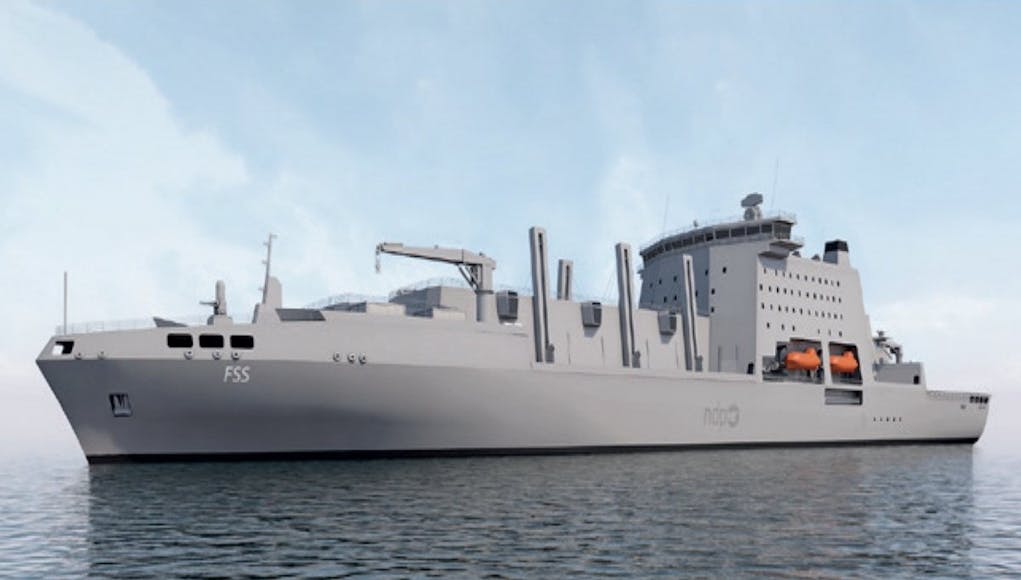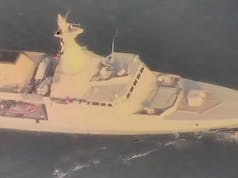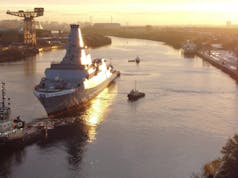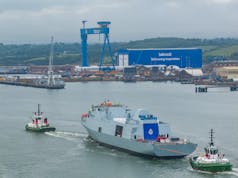Mordaunt appears to have suggested that the new Fleet Solid Support Ship should be built in the UK.
Defence Secretary Penny Mordaunt was speaking at the Royal United Services Institute, where she said:
“It’s long order books and steady drum beats in our yards that strengthen our supply chain and bring down the overall cost of procurement. What is needed is a closer partnership with industry that gives them the confidence to invest and build and us the confidence that we can and must buy British.”
Jude Brimble, GMB National Secretary, said earlier regarding news the contracts could go to Spain:
“The Royal Fleet Auxiliary contracts are the key to unlocking the country’s massive shipbuilding potential. But Ministers refusal to put the UK’s interests first will mean that instead of a massive programme of shared economic and employment re-distribution, our firms will be competing against each other for slivers of complex warship work.
It beggars belief that the Government wants to give this golden opportunity away to foreign competitors when working class communities up and down the country are crying out for decent work.”
Who is bidding?
It is hoped that the bid will be won by Team UK (a UK consortium consisting of Babcock International, BAE Systems, Cammell Laird and Rolls-Royce).
Overseas shipyards who have been invited to tender for the FSS programme include:
- Fincantieri: 70% owned by Fintecna S.p.A the Italian owned investment agency
- Navantia: 100% owned by the Spanish government
- Daewoo Shipbuilding and Marine Engineering (DSME): received a USD 6billion rescue package from the Korean Development Bank and Export-Import Bank of Korea
What’s next?
December of this year will see the formal issue of documentation inviting bids for the design and build contract and in 2020, the contract for design and build is to be awarded.














I think those figures in that list spell out quite clearly why we have been deemed to have been ‘uncompetitive’ over the years. Yes in the 60s and 70s our yards (as in much of our other industry) were ridiculously, intrinsically and structurally incapable of being competitive against far more nimble competitors (a dozen unions v 1 in Japan for example) but given a fair crack of the whip I don’t see that as being the case now. Survival of the fittest is only realistic an industrial plan if everyone plays by the same rules and that is simply not going to happen. Even the supposed epitome of unfettered capitalism the US, manipulate the market to suit themselves with massive defence budgets and hidden incentives (as they are presently doing for Washington State food producers hit by the US/China Trade dispute) and the size of their market alone gives them a massive advantage over a minnow like us. We have been playing a ludicrous and losing game for far too long based on prejudices and out of date thinking that go back to the ‘Im alright Jack’ 50s. Trying to use the US as some sort of poster boy for our industrial strategy is pure madness and hopefully we are slowly learning that lesson… if its not already too late even for the industrial rump that remains.
‘(a dozen unions v 1 in Japan for example)’ – for a long time the employers preferred that situation as it made it easier, with a split workforce, to lay off one group once their area of work was complete.
Very much agree with your sentiments.
It is quite hard to imagine that the UK shipbuilding use to be the world’s largest shipbuilding industry.
But poor industrial relations, politically driven trade unions, lack of investment, political interference and a failure to modernize ensured it’s demise.
I am all for UK shipbuilding but it has to competitive and high quality.
If it cannot then the orders must go overseas.
The defence budget is to supply our military personnel with the best equipment we can afford in the quantities required, not to prop up ailing industries that cannot compete.
Mike, its a catch 22 situation. Lack of work leads to lack of investment because there is no viable means to recoup the investments that you make. Lack of investment leads to a lack of work.
I’ve run my own ( small ) manufacturing business for 28 years and investment decisions are complex to say the least. Ultimately you invest when you believe there is a better than average chance of recouping the investment costs over a realistic time frame. This usually comes about through customers forward planning work with you.
We cannot blame a lack of investment in our ship yards on the ship builders solely. The government should be placing ALL capital expenditure with UK companies that posses the knowledge to complete the work. In the short term it will increase the cost of capital purchasing, but as these companies have confidence in ongoing work they can make the investments required to become globally competitive and so the costs start to fall in the medium term.
The British government is constantly changing its mind and based on that no company will make the investments required for a one off purchase.
It is possible to link work share to investment, so companies taking work share of UK capital expenditure could be contractually obliged to use some of that money to reinvest in their infrastructure.
We as a people are amongst the best in the world at making things, despite all the constant barrage of abuse that UK manufacturing gets from all quarters.
Support UK industry in an intelligent manner, enhance the manufacturing base skill sets and allow enough meat on the bone to reinvest. Even if it costs more to build in the UK the money spent in the UK is taxed and the government gets a tax return of better than 50% ( VAT, National Insurance, PAYE, Corporation tax, reduced benefit bills) So the REAL cost is not the headline figure, but the headline figure minus the Tax return. It is ALWAYS cheaper for the government to buy British.
You make some very good points, but it is not always cheaper for the government to buy British.
In fact that’s a ludicrous statement, every project should under go a cost benefit analysis to identify the best value most capable option.
Example, was the SA80A1 cheaper than buying a foreign competitor?
It cost four times more than a M16 and was worst quality small arm ever produced.
Hi Mike,
I don’t know a great deal about the arrangements for the SA80A1, was it manufactured in the UK ? I was under the impression it was manufactured in Germany, perhaps you can correct me on that point.
Moving forward from that though, would you say that the current version of this weapon is still the worst small arm ever built ? Again my knowledge is very limited but my understanding is that its now regarded as one of the best assault rifles ever built.
So assuming that it was manufactured in the UK and still is then the return on the initial investment may not look as bad as the original purchase contract. Which is sort of my point exactly. Over the years of buying British ( assuming it is British built) how many jobs have been supported ? How much additional tax has been paid to the UK government ? How much money has it saved from having to pay benefits to people who just want to work. All of this vs a total financial loss of buying the M16 from the USA.
I do tend to feel that as a nation we have become used to the service sector investment cycle which is much shorter than the manufacturing investment cycle. It is then difficult for people outside of manufacturing to fully understand a 20 year investment cycle vs a 3 to 5 year investment cycle.
I’m not trying to imply that you don’t understand these concepts, but its frightening just how many people don’t in todays instant world.
Unfortunately the SA80A1 was designed and manufactured in the UK by the Royal Small Arms Factory. The first prototypes were built in the 70s. The idea was to replace the awesome 7.62mm (elephant gun) L1A1 SLR with a lighter weapon, with a higher cyclic rate of fire and was easier for infantry to move about in armoured vehicles. With cost in mind it was hoped that automation would enable quick production and drive down costs, this didn’t happen.
Its main fault is that the weapon was a product of the late 70’s and early 80’s. So much like cars from British Leyland, the quality control was non-existent and suffered significant disinterest from those making it. Wikipedia has a good example from a employer at one of the factories that produced the weapon, as to why the build standard was so shoddy.
The A2 version was an urgent upgrade contracted out to Heckler and Koch (which was owned by BAE at the time). This corrected a lot of the production issues like a stronger return spring, fitting a guard around the magazine release catch, a safety catch made from a different material, new gas parts etc. The A2 weapon is what the original A1 could have been, they really are like comparing chalk with cheese. Compared to a AR15 M4, it is more accurate and retains full auto unlike the M4’s 3-round burst. It is also a lot more reliable than an M4 and doesn’t suffer as much from gas fouling the working parts like the M4 does. Having used both, as well as HK416, I’d put both the 416 and A2 above the M4 for reliability.
However, as a battle rifle the ergonomics are s***. This is because the magazine is placed behind your firing hand. It is quicker and easier to replace the magazine if it’s in front of your firing hand. The HK416 takes the design of the working parts of the A2 and puts them in an M4 style body (Wiki got this part wrong). The only problem is that for an equal length barrel to the A2, the rifle does become awkward to handle like the original M16. The shorter barrelled carbine isn’t as accurate as the A2.
The next battle rifle will probably follow the development of the 6.8mm round currently under tests in the US. As the UK has such an aversion to firearms and is no longer in the game, the next rifle will probably be an import.
The US Army had very similar problems, reliability wise, with the M16 in Viet Nam on its first issue.
Just to inform you the SA80A1 was designed and manufactured in the UK buy Enfield. However, buy the time it need fixing Enfield had gone and the A2 variant was designed buy H&K and installed as well. However, at the time H&K was owned buy BAE and the design staff and work was all done in the UK.
That’s a very good assessment David and I would concur on all points.
Part of the high cost for sa80 was the fact every front line rifle has a SUSAT sight. As far as I know the first in the world and gave us a massive advantage over everyone else
However BAe have had guaranteed work which has led to what most agree to be the most expensive OPVs on the planet. Sir John Parkers report states that there’s a wide variance in cost between yards but those who have commercial orders are lower. So, in short if you have to compete you become efficient and productive if you don’t you become unproductive and expensive like many foreign yards which rely on government subsidies and loans where as our commercial yards don’t.
Mike you are undoubtedly correct in your assessment and prescription of an effective, forward looking purchasing policy. That however won’t save you from the mercantilists ire being readied to launch against you. Plus ca change!
To be competitive and high quality, it needs orders and a it’s own government believing in them.
This whole issues should not be up for discussion. We have to build when we can in the UK, and not to be tied down by silly terminology, of what constitutes a warship and what does not. At the end of the day, we should always strive to increase homegrown excellence.
Good for her,good start to her job, these ships need to be built in the UK to enable the capability to be maintained for follow on large ships like the replacements LPD’s.
There are all ready early studies and I expect about 4 hulls replacing the LPDs Bays and Argus.2 with command facilities and 2 austere fit out.
If government that is the treasury, MoD and the department for international aid get this right with co-operation from the British ship building industry the industry as a whole could be put on a good footing.
There is the possibility of the three FSS ships, two hospital ships have been spoken about and don’t forget the idea of the two forward deployed base ships. That is seven major vessels of 30,000 tons +. Then with the T31 program, T26 program and the replacements for Albion and Bulwark it could see an expansion of ship building for the next 15 years.
I did a cost recovery benefit calculation sometime ago showing that the treasury would recover directly through taxation and a reduction of state benefit payments of circa £500 million only over the period of the FSS construction. That is a 50 % return to the state on initial investment in one form or another.
If we get the FSS designs right who is to say that we could not build some more for other allied nations. No-one believed that the T26 design would be so successful, so why not. It is not that we lack the design capability but governments will power to build the things we need.
I’m liking this lady.
Bravo.
I think we have accept the fact that Europe massively subsidises their industry. Saying the UK is not competitive is simply not the case. I have worked with French companies before and anyone that says they are efficient simply has not worked with them. The same can be said of German companies. Given an even crack of the whip the UK can compete it is just we have been blinded by blanket use of Thatcherism for too long. Thatcher was very good but blindly using Thatcherism without any regard to hidden subsidises or the net tax take is old styled thinking in my opinion. We should have these vessels built in the UK as this will mean jobs, high quality work done to modern safety standards and means we get the tax benefit too.
Successive UK govts have all failed to factor in the importance of maintaining a manufacturing base, including supporting skilled jobs and concentrated solely on unit cost or Political reasons. The Dreadnoughts are being built with French steel. The Type 26’s are using 20,000 tons of Swedish, German and French steel. The argument that buying according to unit cost effective is utterly superfical. It ignores among other things, the widespread cheating of EU rules by European countries. In 2016 a report into why TATA intended closing Port Talbot and moving jobs to the Netherlands and Germany was submitted to Parliament. Data released by Eurostat revealed, quote,”UK’s energy prices were 89% higher than the EU average and 97% higher than that of the EU15.” EU states were simply failing to enforce the taxes payable under the EU’s CO2 Climate Change regulations. The report included this example of how European countries have introduced a system of CO2 tax exemptions. It compares Germany and the UK thus, “the German system benefits almost 2,000 companies to the tune of €5 billion a YEAR. Contrast this with the UK where 53 energy intensive companies have received £160 million over THREE years.” In other words Germany heavy industry is being let off taxes totalling 5 billion euro EVERY year. UK industries are being let off £0.0106bn. It is no surprise that the EU has increased its profits from trading goods with the UK by 1653% between 2000 and 2016. They are screwing us. The Ajax. The MOD rejected the tender to build the 600 “tanks” in Newcastle. Instead awarded the contract to a American Company, using their Austrian/Spainish design, built in Spain, using Swedish steel, with a French gun and German turret and engine. In 2005 Blair refused to award the £2bn contract for trucks for the British Army, the biggest of the 2000’s, to the Birmingham based UK tender. The UK govt followed EU Procurement Rules to be as Blair said, “Good Europeans”. But other EU countries IGNORED EU Rules when they bought their trucks. They argued these were defence items rather tha commercial and Brussels let them bend the Procurement Rules. The French, German, Italian, Dutch, Spanish, Austrian, Swedish armies ALL drive trucks built by their OWN industries. The British Army now drives 7200 trucks built in Germany. These are just a few examples. But bear one thing in mind. As the article says the South Korean govt felt supporting their manufacturing base was worth the $6 billion grant to Daewoo which allows the yard to undercut British yards. The above are just a few examples and does not consider all factors. But once the UK defence and manufacturing base is gone, the UK’s ability to defend itself or act in our national interest may one day depend on the good will of the President of the EU Commission.
Quite. Greed, short term thinking and lack of self respect by those who govern. Establishment chumocracy..I’m alright Jack.
Alleluja! Penny Mordaunt is spot on. You can do nothing without faith, and that starts by HM Govt and the MOD having some in British engineering and British workmanship.
I believe the oft quoted criticism of BAE in respect of River 2 pricing is a pejorative interpretation of events. The MOD was contracted to pay BAE regardless of what was made. Well used to their customer’s institutionalised indecision they protected themselves by insisting on a contract which guaranteed a stready cash flow and hence continuity of capability.
None if this excuses poor workmanship on R2 course. But that is a separate issue. I like to think it was the result of an isolated bad apple or inadequate supervision of an apprentice.
Can’t argue with the logic that ‘full books’ keeps the workforce’s current on building vessels. If we keep it up then that should (that’s SHOULD) keep prices down if we have a steady workforce rather than having to ramp up and then lay off and then ramp up….
Of course, we would also need to have a realistic working relationship between the MOD and the builders, if the MOD are happy with what they’re getting then export orders might follow, its not always been the case.
Good. Very good
I wonder how long it will take to build and enter service given that the first Type 26 will not be in service until 2027?
In the case cited below, think quantity, not quality.
“The ship is being built in the same dry dock used for construction of the seventh Type 071. A considerable number of modules for the latest ship were evident on the dockside before the seventh vessel was launched on 28 December 2018, which has enabled the hull of the latest LPD to be assembled in less than six months.”
https://www.janes.com/article/88529/china-s-eighth-type-071-in-advanced-stage-of-construction